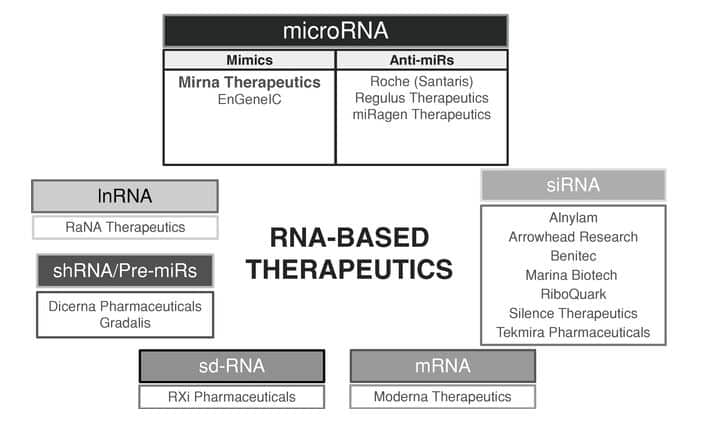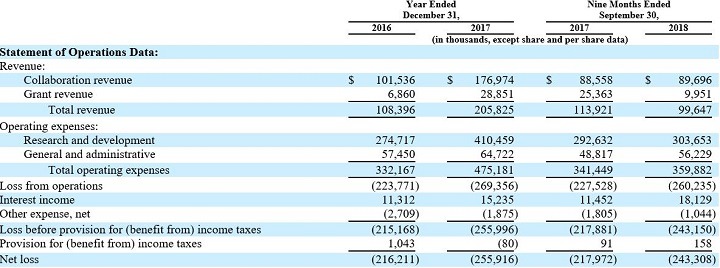Moderna Stock Offered in Planned IPO
Table of contents
It’s always kind of comical to see financial pundits make a 50/50 call about some binary outcome in the future and then act like they’re the second coming of Nostradamus when the coin happens to land on heads. In the world of finance, it’s easy to pick one side of an outcome and then bring it up later, but only if your prediction was accurate. In August of 2015, we correctly argued that Moderna Therapeutics Won’t IPO Anytime Soon – largely because they had such a huge stockpile of cash at the time – and also because the company kind of said so. Well, “soon” is now far in the past, and Moderna (formerly known as Moderna Therapeutics) just announced a planned IPO days ago in which they hope to raise $500 million. Let’s dig into Moderna’s S-1 and see what’s going on with the company since we last looked.
Moderna’s Pipeline
You can read our past article on Moderna to get up to speed on the company or we can just give you the following ultra-brief summary. Founded in 2010, Moderna has taken in $2.6 billion in total funding to “commercialize a new category of medicines to treat human diseases” which consists of the sizable drug candidate pipeline seen below:

Not only do we see a sizable number of drug candidates addressing a broad range of modalities, but a number of their 21 pipeline drugs (10 of which are in clinical studies) are being worked on in conjunction with pharma giants Merck and AstraZeneca (yellow highlights in the above pipeline.) In some cases, Moderna has been promised 50% of future profits from a drug they are developing. Imagine having the leverage to tell Merck they need to hand over 50% of the profits for a drug candidate that’s not even cleared Phase 1 trials? Maybe it’s the strength of Moderna’s technology that allows them to command these types of premiums during negotiations.
Moderna’s Technology – The Software of Life
Moderna is dabbling in an area that’s broadly referred to as “RNA-therapeutics,” and they describe their technology in big terms like “the software of life”. The technology Moderna uses is something we touched on before called mRNA. The below diagram from the company explains the technology platform in simple terms so we don’t have to:

Moderna has built a strong intellectual property portfolio around their mRNA technology platform with over 1,500 patent applications filed in the past eight years, and over 100 issued or allowed U.S. and foreign patents. The fact that large pharmas have sidled up to Moderna means that the technology has some serious potential, and everyone wants a piece of that just in case it all pans out. In this case, Moderna has 21 chances to get things right and land a blockbuster. However, based on the $2.6 billion that investors have put into the coffers so far, it’s likely that multiple blockbusters are expected here. Having investors like the Bill and Melinda Gates Foundation, DARPA, and the U.S. Department of Health and Human Services on board usually means that the potential impact on society may be quite high if things go well. Sell to the poor, live with the rich kind of stuff.
It’s important to note that Moderna’s not alone in the development of RNA-therapeutics. We dusted off this old diagram from many years back which shows all the players in this space (at the time), but the main thing we want to point out here is that there are many different forms of RNA-therapeutics, Moderna’s mRNA being just one of them:

Last year, one of Moderna’s competitors that isn’t listed above, Arbutus Biopharma Corporation (ABUS), made a public statement to the effect that Moderna’s intellectual property isn’t sufficient enough for the company to move forward without an intellectual property battle. That sort of rhetoric is probably why Moderna has spent upwards of $480 million on developing their platform and securing their intellectual property position. They have plenty of dry powder as well, with $1.2 billion in cash on their books as of September 30, 2018.
Moderna’s Financials
While a $1.2 billion stockpile of cash sounds like a lot, it’s not when you consider that this 680-employee company is spending like mad to get ahead of the pack. They’re generating revenues through their collaborations, but at the same time spending loads of money on their platform. Here’s a look at some numbers that tell us the company is on a trajectory to burn at least $250 million for 2018.

With investors like Pictet, Abu Dhabi Investment Authority, and Julius Baer on board, we can be reasonably certain that Moderna’s financials are being closely monitored by teams of MBAs who have put together massive spreadsheets that attempt to value the investments being made into Moderna, and more importantly, try to forecast a profit that could be made on those investments. (Sensitivity analysis anyone?) Like most pharma companies, expect Moderna to have lots of volatile price swings that coincide with drug approval progress announcements. (This wreaks havoc on those valuation models.)
Moderna’s “Controversy”
There’s nothing like a bit of controversy to get people all riled up, and Stat News penned a piece a few years back titled Ego, ambition, and turmoil: Inside one of biotech’s most secretive startups which starts by saying “at first glance, Moderna Therapeutics looks like the most enviable biotech startup in the world” but that “the reality is more complicated.” The article then goes on to talk about a CEO who runs a tight ship, with a work environment that features abusive emails, dressings down at company meetings, exceedingly long hours, unexplained terminations, and high levels of secrecy. Sounds like Moderna operates much like an investment bank does, with little tolerance for incompetency. The 6,000-plus-word article also mentions an anonymous Moderna employee who took time away from their busy schedule to say the following to Stat News:
He doesn’t suffer fools lightly,” the analyst said, speaking on condition of anonymity to comply with company policy. “I think if you’re underperforming, you’ll probably find yourself looking for another job.
Sounds like a great CEO who gets stuff done. Moving on.
Moderna’s IPO
So, let’s just summarize what we’ve talked about so far that’s led up to this IPO by Moderna:
- In 2015, Moderna says they don’t want to IPO anytime soon
- In 2016, Stat News talks about how tough the work culture is at Moderna
- In 2017, the CEO of competitor Arbutus states “Moderna Can’t Escape My Intellectual Property“
- In 2018, Moderna takes in $625 million from investors that included asset manager Fidelity, the aforementioned Merck, and Sequoia Capital
- Last Friday, Moderna files for what would be the biggest biotech IPO in U.S. history
Seems like things are on track for Moderna if the $625 million they raised during this year is any indicator. While CB Insights lists Moderna at a $3 billion valuation on their “unicorn list“, an article by Fortune claims that Moderna has raised $2.6 billion at a $7 billion valuation. Any way you look at it, a lot of people are convinced that Moderna’s mRNA platform has legs.
Conclusion
The complexity of life sciences technologies means that we’re all better off letting someone else vet the technology who knows what they’re doing. When pharma companies like Merck and AstraZeneca invest in life sciences startups, it’s a vote of confidence that there is some serious potential along with some formidable intellectual property. The fact that Moderna has been able to raise $2.6 billion ($1.8 billion from equity issuances and $0.8 billion in upfront payments, milestone payments, and option exercise fees from strategic collaborators) shows that the CEO is doing his job and raising the funds needed for the company to grow. A successful IPO will result in more brand exposure for Moderna and even more capital to grow with.
Because we only hire the best MBAs we can find afford, we’re able to do make the sort of astute predictions like we did with Moderna – that we would never brag about – so we’ll leave you with one more gem of wisdom. We’re cautiously optimistic about the Moderna Therapeutics IPO and suggest that you dollar-cost-average your way into a size-appropriate position as opposed to putting it all on red during the first day of trading. If that bit of advice proves to be astonishingly effective, we’ll be sure to bring it up again later.








